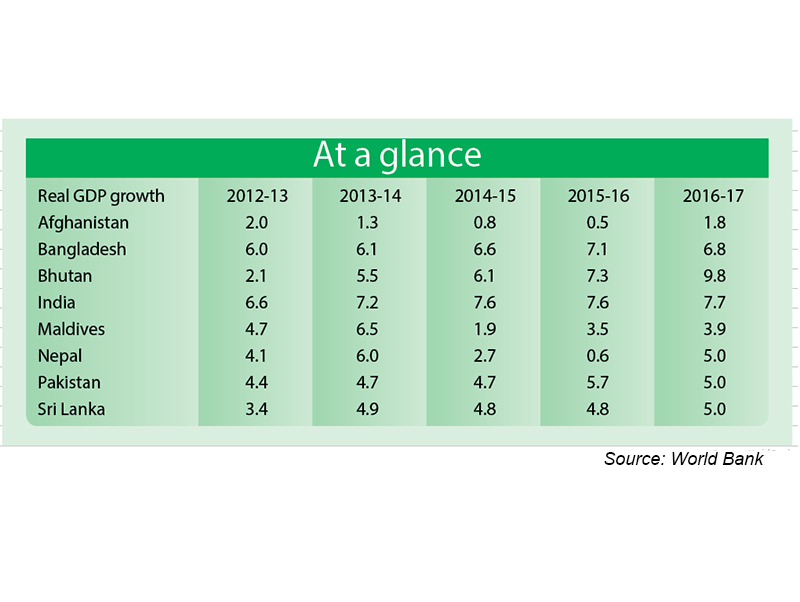World Bank projects Nepal’s economy to rebound to 5pc
The World Bank has projected Nepal’s economy to rebound to five per cent this fiscal after clocking an anaemic growth of 0.6 per cent in the previous fiscal due to the devastating earthquakes and months-long trade disruptions.
Unveiling the bi-annual South Asia Economic Focus, today, the bank has said, that ‘agriculture and construction are expected to improve on account of a good monsoon, while increased disbursements of housing reconstruction grants will help as well’.
World Bank’s projection, though more optimistic than Asian Development Bank’s estimate of 4.8 per cent, still falls short of government’s forecast of 6.5 per cent.
The report has said Nepal faces several simultaneous and daunting challenges: From completion of political transition and setting up of a new federal structure to successfully leveraging its endowments (hydropower potential, human capital) to achieve rapid growth, faster poverty reduction and expanding economic opportunities for its citizens. Regaining investors’ confidence, particularly for hydropower development, is an added challenge after a series of shocks for a country that does not have a favourable track-record in mobilising large-scale private investment.
In terms of the region, the report says South Asia has defied a sluggish world economy and solidified its lead as the fastest growing region in the world in 2015-16. Led by solid performance in India, economic growth is expected to gradually accelerate from 7.1 per cent in 2015-16 to 7.3 per cent in 2016-17.
“A reality check reveals that private investment — a key future growth driver across South Asia — is yet to be ignited to sustain and further increase economic growth,” a media release issued today has quoted Annette Dixon, World Bank South Asia Region’s vice president, as saying. “Countries will need to activate the full potential of private investment and exports to accelerate economic activity further, reduce poverty and boost prosperity.”
A reality check on the state of private investment in South Asia shows that the region has fallen short of expectations. Mobilising domestic savings remains key at the aggregate level. However, remittances and foreign direct investment prove very effective on a per-dollar basis, and the region should make the most of them, according to the report.
“Political economy risks are widespread across South Asia, and uncertainty will need to be managed, particularly with a view to creating an attractive environment for domestic and foreign investment alike,” the release has also quoted World Bank South Asia Region’s Chief Economist Martin Rama as saying. “Delivering the necessary energy, infrastructure, and regulatory improvements remains critically important to increasing private investment, thus boosting job creation and reducing poverty.”
According to the bank, many South Asian countries show potential for accelerated growth in the short- to medium-term. “However, countries will need to sustain domestic demand as a pillar of growth while reactivating exports and tapping the potential of private investment.”
Afghanistan’s economy is expected to make a slow recovery over the next three years. Growth is projected to decline to 0.5 per cent in 2015-16, and gradually increase to 1.8 per cent in 2016-17.
Growth in Bangladesh will be sustained at 6.8 per cent in 2017, coming slightly down from 7.1 per cent in 2015-16 and with most economic indicators being stable, as per the report. Bhutan’s economy is expected to grow at 7.1 per cent in 2015-16 and 9.8 per cent in 2016-17.
In India, GDP growth will remain strong at 7.6 per cent in 2015-16 and 7.7 per cent in 2016-17, supported by expectations of a rebound in agriculture, civil service pay reforms supporting consumption, increasingly positive contributions from exports and a recovery of private investment in the medium term.
In Maldives, GDP growth is expected to remain modest at 3.9 per cent in 2016-17, up from 3.5 per cent in 2015-16, but held back by a slowdown in tourist arrivals, especially from Russia and China.
In Pakistan, growth is projected to decelerate from 5.7 per cent in 2015-16 to five per cent in 2016-17. Sri Lanka’s economy is projected to grow at five per cent in 2016-17, up from 4.8 per cent in 2015-16 and driven by increased private consumption and postponed investment in 2014-15.
The report was published on the eve of unveiling of ‘Nepal Development Update’ 2016.
IMF outlook
KATHMANDU: The International Monetary Fund (IMF) has projected that Nepali economy will grow by 4.05 per cent in current fiscal as compared to 0.6 per cent of last fiscal. Similarly, average inflation will hover around 9.9 per cent. The IMF has expected the government’s borrowing will be around 1.5 per cent of gross domestic product and current account is expected to record negative balance of 0.9 per cent of GDP.






